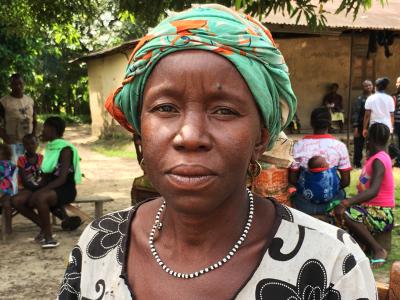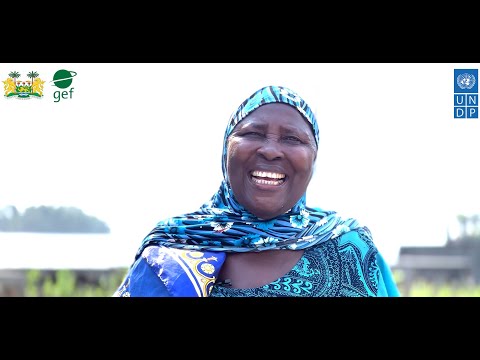
The coastal zone of Sierra Leone is highly vulnerable to the increased frequency and severity of coastal erosion, flooding and storm surges which severely impact social wellbeing, livelihood security, water resources and major economic sectors such as fishing, tourism and agriculture. Coastal communities are already experiencing considerable repercussions of these impacts, notably on their livelihoods with reduced fishing productivity, ecosystem degradation and low farming outputs. The limited accessibility of climate-related data – in particular marine and sea parameters databases such as wave height, wave period, wind speed and direction – affects the ability of decision-makers to make informed planning and policy decisions for the coast and to take any clear strategic actions to remedy these negative effects. This inadequate lack of knowledge is contributing towards undermining social and economic development, particularly under a changing climate.
The "Adapting to Climate Change Induced Coastal Risks Management in Sierra Leone" project (2018 - 2023) sought to strengthen the ability of coastal communities to systematically manage climate change risks and impacts on physical infrastructure and economic livelihoods. The project worked along the coastal zone in six pilot sites (Conakry Dee, Lakka, Hamilton, Tombo, Shenge and Turtle Island).
Key national partners included the Environmental Protection Agency (EPA SL), the Ministry of Fisheries and Marine Resources (MFMR), the Institute of Marine Biology and Oceanography (IMBO) and the National Tourist Board (NTB).
- National
- National Governments
116,000 people
- United Nations Development Programme (UNDP)
- Global Environment Facility (GEF)
Expected outcomes
Outcome 1 - Enhanced availability of high quality climate risk information that is critical for development decision-making in the coastal zone.
Outcome 2 - Appropriate protection measures, policy, budgeting and legal tools and integrated coordination mechanisms developed to improve and support policy design and implementation in dealing with current and long-term coastal challenges.
Outcome 3 - Public awareness enhanced and climate resilient alternatives to sand mining promoted for better adhesion of policy makers and communities on adaptation.
Studies and results relating to climate change impacts from Sierra Leone’s National Adaptation Programme of Action (NAPA, 2007) revealed that rainfall and temperature patterns experienced in Sierra Leone are changing. Projections of mean annual rainfall averaged from different climate model predictions show a wide range of changes in precipitation, though all indicate a trend towards overall precipitation increase, particularly from July to December. Regional trends, indicated by the IPCC AR4, also anticipate that climate change will result in increased rainfall variability and frequency and intensity of extreme weather events, including Sea Level Rise and higher storm surge risks within West African Coastal regions. Further, results from recent studies carried out as part of the second national communication (GEF-UNDP, 2012) confirm these climate change trends with records of extreme rainfall events, extensive coastal flooding throughout the country, and severe and extensive coastal erosion as result of both heavy rainfall and tidal activity.
The continued vulnerability of coastal communities in Sierra Leone to climate induced risks and related hazards are deemed a key problem. This is further exacerbated by the limited access to accurate and timely climate data and information that can be used to inform decision-making on the coast. In addition to this key problem, weak institutional regulatory capacity coupled with the absence of a national “coastal specific” community-based information system that focuses on supporting the management of climate-related risks continue to hamper long-term coastal planning, management and early warning activities. This thereby affects the ability of coastal communities to effectively and efficiently adapt to the pressures of climate change. The introduction of innovative and resilient livelihood options to address the issue of sand mining along the coast of Sierra Leone shall provide a sustainable and economically viable solution that may be embraced by the GoSL and the construction sector.
Aligning with the SDGs
- SDG 1: End poverty in all its forms everywhere - This project aims to improve flood and marine forecasting within the coastal zone of Sierra Leone, providing useful climate information such as daily and seasonal forecasts, particularly for coastal fishing communities. By 2030 the project will seek to improve the resilience of the poor, reducing their exposure and vulnerability to climate-related extreme events and other economic, social and environmental shocks and disasters.
- SDG 2: End hunger, achieve food security – The project will contribute towards ensuring that sustainable food production systems are initiated and that climate resilient agricultural practices are implemented within vulnerable coastal communities so as to increase productivity and production. The project will work with local Women’s Associations and develop resilient coastal small-scale farming including the provision of small scale water sources and irrigation systems to withstand droughts.
- SDG 5 Achieve gender equality – Women account for over 90% of the people engaged in fish marketing, over 80% of retailers of food products and vegetables, and over 90% of operators involved in the artisanal processing of agricultural and fishery products. The project shall seek to ensure that women will be better empowered by enabling them to have access to financial services through a newly established Community Grant Facility, encouraging them to take action to get involved in local coastal adaptation projects that invest in sustainable livelihood activities.
- SDG 11: Resilient cities and human settlements - The project will effectively develop national capabilities to better predict future climate scenarios of sea level rise and its related impacts on coastal communities. It will also work to create systematic processes for packaging, translating and disseminating climate information and warnings.
- SDG 13: Fighting climate change and its impacts - The project will undertake a detailed topographic analyse along the coastline to develop coastal erosion profiles. This will allow for better detailed setback values and the development of a national coastal zone vulnerability and risk mapping programme. The new knowledge base generated on future climate risks will be integrated into national policies, strategies and planning processes. The project will also improve education, awareness-raising and human and institutional capacity strengthening on topics such as climate change adaptation, impact reduction and early warning systems.
- SDG 15: Protect, restore and reverse land degradation – In an attempt to restore degraded mangrove forests, the project will support ecosystem-based interventions (including mangrove afforestation and reforestation programmes) as well as promoting the implementation of sustainable community based alternative income generation activities to help address deforestation.
Outcome 1 - Enhanced availability of high quality climate risk information that is critical for development decision-making in the coastal zone.
Output 1.1: Climate and oceanographic monitoring network (with 6 automated oceanographic monitoring systems) and related data processing systems installed along the coastal zone to improve the knowledge base for measuring future climate induced risks.
Output 1.2: Institutional capacity of MFMR, EPA-SL, SLMD, ONS, SLMQ and IMBO for assessing coastal hazard risk and vulnerability to climate change through probabilistic modelling is strengthened.
Output 1.3: A systematical link between the collected data and the existing CIDMEWS (web based GIS) is established.
Output 1.4: The human capacity of the MFMR, EPA-SL, MLGRD is strengthened and trained on CVA techniques.
Outcome 2 - Appropriate protection measures, policy, budgeting and legal tools and integrated coordination mechanisms developed to improve and support policy design and implementation in dealing with current and long-term coastal challenges.
Output 2.1: Sea Level Rise and coastal erosion profiles developed for the six target pilot sites to support the strengthening of Coastal Zone Management Plans at both urban and district levels.
Output 2.2: Ecosystem-based adaptation design guidance to support future climate resilient planning and development in place.
Output 2.3: Marine spatial plan framework to compliment with ICZM is developed.
Output 2.4: Sierra Leone ICZM is strengthened with the establishment of SL-ICZM-WG and sustainability mechanisms.
Outcome 3 - Public awareness enhanced and climate resilient alternatives to sand mining promoted for better adhesion of policy makers and communities on adaptation.
Output 3.1: An outreach communication, information and awareness strategy designed and implemented to enhance decision-making and foster public awareness and safety about the potential impacts of climate change;
Output 3.2: Adaptation strategies for alternative livelihoods are designed to strengthen women and sand miner youth association’s resilience to CC impact on the coastal zone so as to reduce pressure on natural resources.
Output 3.3: CSEB practices are introduced to mitigate the risk of unregulated sand mining in Sierra Leone.
Output 3.4: Participatory implementation of urgent and priority medium-scale soft (non-structural) and hard (structural) coastal adaptation works undertaken to protect coastal community at risks.
Output 3.5: Early Warning Systems are extended to target sites in the coastal zone to protect fishing and farming communities.
- UNDPClotilde GoemanRegional Technical Advisor


